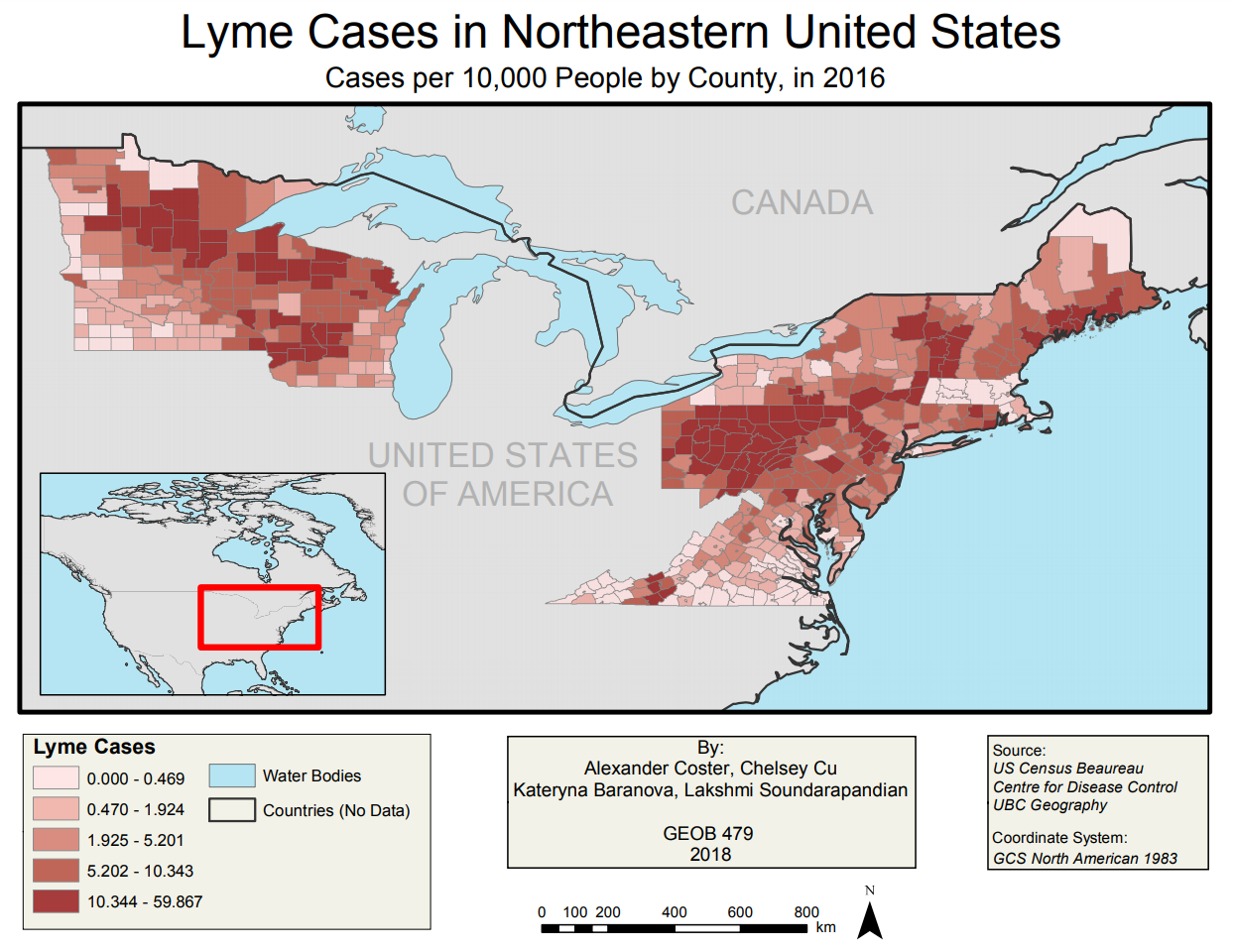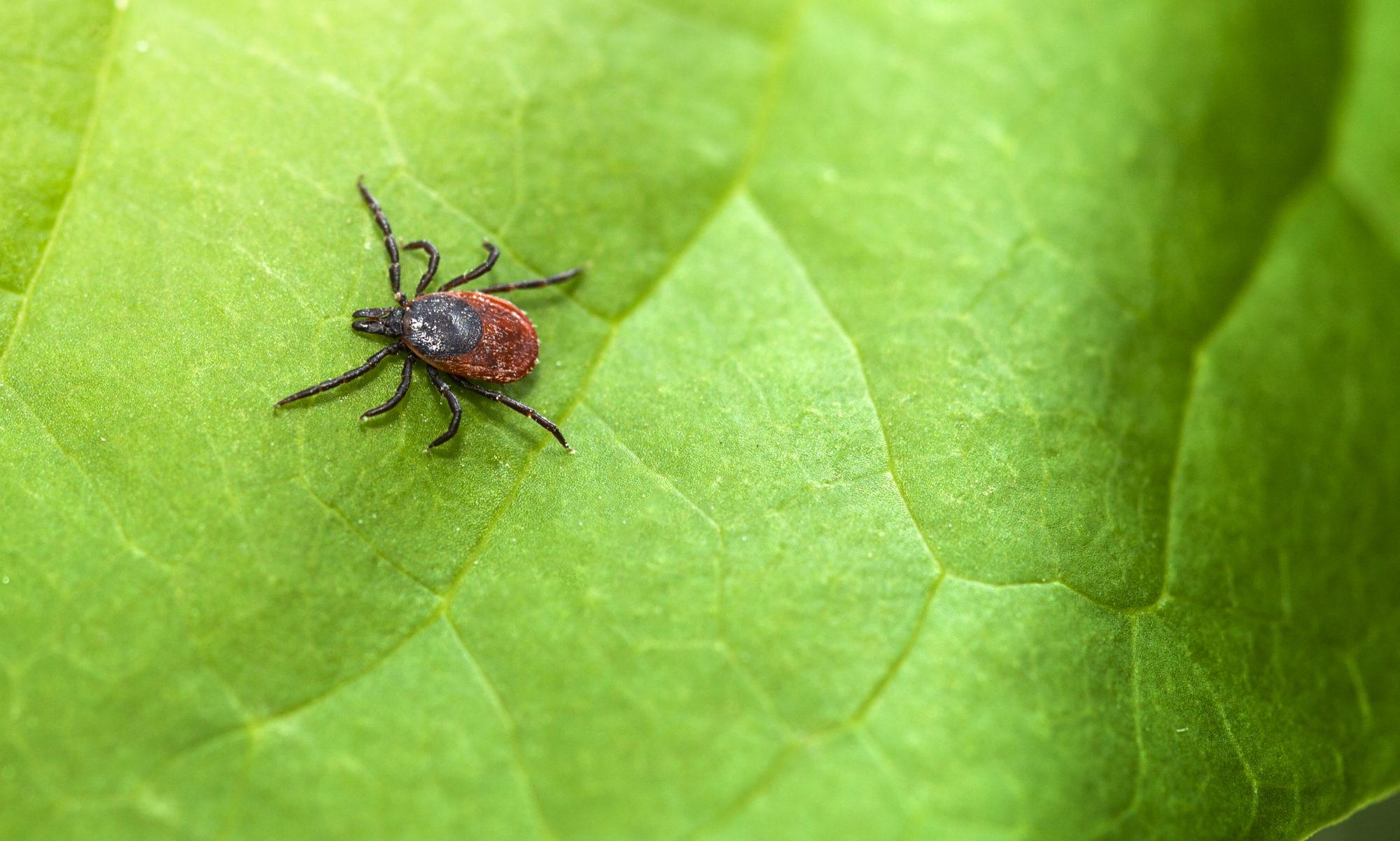introduction
Lyme disease, caused by the bacteria Borrelia burgdorferi (B. burgdorferi), is an infectious disease found throughout Europe, North America and Asia (Wormser et al., 2007). It is caused by tick bites, most commonly from the blacklegged or deer tick (Ixodes scapularis) (Marques, 2010; Aucott et al., 2013; CDC, 2015; Stafford et al., 2014). As such, this study looks at lyme disease in the northeastern United States region, focusing on 14 states that have been identified by the Centers for Disease Control and Prevention (CDC) as having experienced the most recorded cases. These states include Connecticut, Delaware, Maine, Maryland, Massachusetts, Minnesota, New Hampshire, New Jersey, New York, Pennsylvania, Rhode Island, Vermont, Virginia, and Wisconsin (see Map A)(CDC, 2017). Our analysis incorporated the statistical analysis program MaxEnt, a software that uses maximum entropy modeling and various environmental factors to model the distribution of the species of interest, providing a probability or prediction grid of appropriate conditions for species occurrence (Phillips et al., 2018). By examining several variables through MaxEnt, three models were produced to in order to get the final results for ideal locations for lyme disease. The results were then extrapolated to 2050, in hopes to determine how climate and land cover change would affect the spread of the disease.

About Ticks
The black-legged tick has three developmental stages: larvae, nymph and adult, which all feed on the animal hosts (Chen et al, 2015). This species has a life cycle of two years, thriving in areas with an abundance of hosts and ideal environment conditions (Cheng et al., 2017). While feeding on host species, ticks pick up B. burgdorferi and act as a carriers, subsequently infecting other animals upon which they feed (Chen et al, 2015). Ticks spread the disease while most commonly in their “nymph” stage, while they are less than 2 mm in length (CDC, 2015) and often go unnoticed when they attach to various parts of the human body such as the scalp and armpits (CDC, 2015). In fact, a majority of infected patients do not recall getting bitten (CLDF, n.d.).
According to Malysa (2017), ticks require three essential elements for survival in an environment: warm temperatures, high humidity, and an abundance of potential hosts. If temperatures fall below a certain threshold, there is a poor chance of larvae survival (Cheng et al., 2017). Climate change has resulted in an overall increase in average global temperatures as well as an increase in precipitation, which provide ideal conditions for tick populations. Looking at the dispersal patterns and ideal environments for ticks can therefore indicate areas where B. burgdorferiI are prominent.
However, due to their small size, ticks have a limited capacity for dispersal into new territories and as a result, long distance dispersal is highly dependent on host populations. The white-tailed deer are the dominant hosts for tick populations and are therefore an important factor in this study.
About deer
Odocoileus virginianus, or white-tailed deer, are the hosts for Lyme-carrying ticks (Kilpatrick et al., 2014). After the 18th and 19th centuries, when major forest clearance had occurred in northeastern United States, white-tailed deer populations significantly decreased or disappeared altogether, only to rebound once landscaping changes occurred after this time period (Stafford et al., 2014). With new forested areas and the regrowth of habitat, white-tailed deer populations increased, thereby providing the host that ticks needed to spread and survive (Stafford et al., 2014). With this expansion came the increase in Lyme disease cases in the region (Stafford et al., 2014).
However, it is important to understand that while the white-tail deer is host to the ticks and plays an important role in the existence of disease carrying ticks, they are not the source of the Lyme disease bacteria, (Stafford et al., 2014). The relationship between the parasite and host is so strong that many studies in the past have found that decreasing deer populations – through fencing, relocation, controlled hunting, and birth control – decreases the existence of Lyme disease, and an increase in disease cases corresponds to excessive deer population (Kilpatrick et al., 2014; Stafford et al., 2014).
About Lyme Disease
Lyme disease is the most common vector borne disease in the United States, and an endemic in Asia and Europe. In our area of focus, there were 38,069 reported cases of Lyme disease in 2015 alone (CDC, 2017; Adams et al., 2017). From previous years, as shown in Graph A, it was observed that the geographical range of Lyme disease was increasing, as well as the number of reported cases (the number of counties with more than 10 cases per 100,00 people grew from 324 in 2008 to 424 in 2015), which initiated our investigation of this phenomenon (Adams et al., 2017). Contraction of Lyme disease is most common during warm weather, such as summer and spring seasons (Marques, 2010), which also corresponds to increased outdoor activity for humans.
The first symptoms of Lyme disease are headaches, sore throat, and congestion (CLDF, n.d.). Therefore, it is commonly disregarded and misdiagnosed as a common cold or flu (CLDF, n.d.). Initially, the disease begins as a skin infection or rash called erythema migrans at the site of the tick bite and spreads to cover between 70 to 80 percent of the individual’s body and can even develop into an erythema migrans lesion (Aucott et al., 2013; Ozdenerol, 2015). It can also worsen to affect bloodstreams, joints, produce neurological complications, and lead to more serious health issues such as cranial neuritis, carditis, and meningitis (Aucott et al., 2013). It can have effects on every system and function of the human body including the digestive and excretory systems in the form of diarrhea, constipation, and irritable bladder, and the reproductive system in the form of menstrual and pelvic pain (CLDF, n.d.). Aside from physical effects, severe cases of Lyme can also cause memory loss and produce challenges in mental capability (CLDF, n.d.). The early detection of the disease leads to a course of antibiotics for curing the symptoms (CDC, 2017). However, certain people may still experience joint and muscle pain after treatment, which is known as Post-Treatment Lyme Disease Syndrome, or Chronic Lyme disease, and must be treated in a different manner (CDC, 2017). With such a grand array of impacts, Lyme proves itself as a serious health issue which significantly impacts the livelihoods of thousands.

Next section: Methodology
